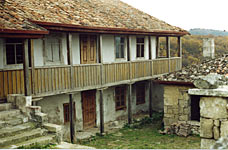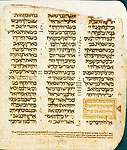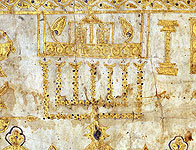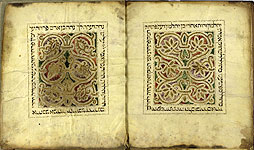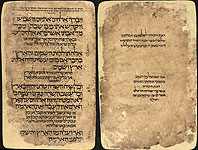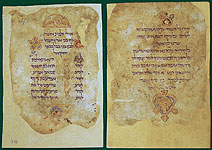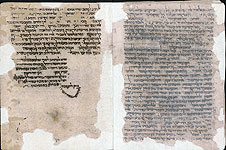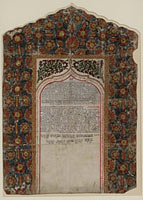Second Firkovich Collection
In 1863, 76-year-old collector accompanied with his wife Khana and grandson Samuel went on the second trip to the Middle East where amassed even more extensive collection for a year and a half. Firkovich visited Istanbul, Beirut, Jaffa, Jerusalem, Nablus, Aleppo and everywhere acquired manuscripts. But it was Cairo where he much increased his collection. From the Karaite community of this Egyptian city, he bought antiquities kept in the geniza of the old Karaite synagogue for a thousand silver rubles. A geniza ( in Hebrew: "storage") is called a repository of worn-out or banned books and manuscripts. Genizas were commonly located in attics, basements or other closed storerooms in synagogues. Firkovich already had experience on the acquisition of the contents of genizas in Karasu-Bazar (now Belogorsk, the Crimea) and in Nablus, and he knew that he could find ancient and rare manuscripts in such storages.
The last years of his life Firkovich lived in a secluded house on the edge of a cliff in the dead city of Chufut-Kale near Bakhchisaray. There he sorted out, read, examined, and described the manuscripts acquired in the East. Firkovich died on 30 June 1874 and was buried at the old Karaite cemetery in the valley of Jehoshaphat, near his last place of refuge.After his death, in 1876, heirs of the collector sold what became named the Second Firkovich Collection for a very large sum to the Imperial Public Library. The Second Firkovich Collection currently consisting of about 17,000 items, including his personal archive, is now dispersed among a number of sections: «Biblical Manuscripts on Parchment», «Bibles on Paper» etc. Codices and fragments of the Bible of the greatest cultural-historical and artistic value are kept in the section «Biblical Manuscripts on Parchment». Among the most noteworthy items is, first of all, the Pentateuch of 929 – the oldest illuminated dated Hebrew manuscript. One of the five ornamented pages depicts golden articles of worship, used in the Tabernacle of Moses (the portable sanctuary from the period of the Exodus from Egypt) and later in the Temple in Jerusalem. These things were described in the Book of Exodus: in the center is the seven-branched candelabrum menorah, under it are the ark and two tablets whith leaves-wings on the sides (wings are symbols of cherubim), the altar of incense is placed to the right, little lower is a jar of manna, etc. It is interesting that gold floral ornaments in this manuscript as well as in separate sheets of the other various copies from the 10th to 11th centuries, produced in the Middle East, Fig. 8–9), bear significant resemblance to the ornamental patterns in early Qurans. The Second Collection contains also biblical manuscripts created in Spain, for example, the Last Prophets, the "biography" of which can serve as a demonstration of the popular phrase, 'Books have their own destiny'. About 1260, a four volumes Bible was produced, probably, in Toledo. Later, the three volumes were found in the French city of Marseille; the first was lost and then replaced by another rewritten in the 16th century. The fourth volume fell into Firkovich’s hands, and then was bought by the Imperial Public Library at Saint Petersburg. The book was decorated with four full "carpet" pages and the page with a colourful headpiece (a frame). The illuminated pages were published in the Stasov-Ginzburg album. In 1992, the manuscript disappeared from the Library and, after a while, at a bequest of its new owner, entered the University Library of Toronto (Canada). The printed album of Stasov-Ginzburg enabled Canadian experts to identify the Last Prophets as part of the holdings of the National Library of Russia, and, in 2006, it was returned to St.Petersburg. Unfortunately, even when the manuscript entered the University Library in Toronto, it already had lacked two carpet pages and the page with the ornamental headpiece. A two-volume copy of the Pentateuch with the Arabic translation by Saadia Gaon in Jewish letters is a highlight of the section «Bibles on Paper». The Pentateuch is attributed to the scribe Samuel ben Jacob who also transcribed the already mentioned Leningrad Codex in 1010, so the book can be dated to the period of the late 10th – the early 11th centuries. In the Library, this is the only large size codex dated to such an early time, written on paper. The comparison of the two manuscripts - parchment and paper books which have come from the pen of the same calligrapher, shows the clear difference between them. The parchment manuscript tends to be square-shaped, the text is arranged in three columns; the paper book has the shape of a vertical rectangle, the text is not split into columns, but visually divided in a horizontal way: a Hebrew sentence written in large letters alternates with an Arabic translation in smaller letters. Very remarkable is a paper Bible (The Prophets) of small size, some pages of which are adorned with colourful ornaments. It was copied in 1122 in Alexandria.
Fiction is also represented in the Second Firkovich Collection, for example, poems by the Spanish Jewish poet Judah Halevi. Firkovich has gathered works on various branches of knowledge: philosophy, law, philology, physical sciences, medicine and much more. Noteworthy is a part of the 13th century miscellany, containing a copy of the letter from the king of the Khazars Joseph to Hasdai ibn Shaprut, a Jewish dignitary in the court of the Caliph in Cordova (Fig. 21). Their correspondence is dated to the mid-10th century and relates to the adoption of Judaism as the state religion by the Khazar Empire.
In addition to Jewish writings proper, the collection includes Hebrew texts transcribed in Arabic letters (Fig. 14), and, conversely, Arabic texts written in Hebrew characters. Among the latter, of great interest is a paper fragment from Jacob Qirqisani’s Book of Lights and Watchtowers of the 10th century, which is the presentations of the doctrines of the Karaite faith. The fragment is dated to 1006, it is the oldest dated Hebrew manuscripts on paper. Saadia Gaon, a contemporary of Qirqisani, not only translated the Bible into Arabic (Fig. 10), but also created several of his own writings, including his philosophic work, The Book of Beliefs and Opinions, in fluent Arabic. In it, Saadia provides an account of Jewish belief. The well-known medical work, – Canon by Ibn Sina, rewritten in 1420 in Italy should be also mentioned. The Firkovich Collection embraces documents in Arabic, Hebrew, Aramaic, and other languages. For example, the marriage contract (ketubba), signed in 1719 in Chufut-Kale. This contract was stolen from the Library in 1992 and later was purchased by in the Israel Museum which returned it to our library after research that revealed that the document was from the Fircovich Collection.Most of the manuscripts of the Second Copllection are fragments from codices without bindings, which are often significantly damaged. This is no wonder, because they were found in the genizas. Restoration and preservation work began immediately after the acquisition of the Firkovich Collection and does not cease to this day.
